
You can find out how to configure your navigation app or software to receive NMEA, GPS and AIS data from one of Digital Yacht’s NMEA to WiFi server, NMEA to USB converter or AIS receiver/transponder with built-in WiFi
This list only includes apps & software which can receive external NMEA data and display real time AIS targets from an AIS receiver/transponder. If you are a software/apps editor and your app/software is not in the list below, please contact us.
Once you have connected your tablet or smartphone to the WiFi of the NMEA to WiFi server or the AIS transponder/receiver, open the app. Aqua Map can receive all NMEA 0183 data such as GPS, AIS and instruments data. Aqua Map is also Signal K compatible and can receive Signal K data from our iKommunicate.
Go to the Settings.

Toggle the buttons next to AIS and NMEA.
Make sure your Aqua Map Master subscription is active, then click on the arrow next to WiFi Connections.

Click on ‘+’ next to List of Connections.
Then, in the next page, you can fill in the parameters to set up an NMEA connection. However, our products parameters have already been saved by the app. So, simply click on the button Select device and select Digital Yacht.
Otherwise you would have needed to add the Connection name, the protocole TCP or UDP, the ip address: 192.168.1.1 and the port n° 2000.

Choose Digital Yacht and click on Done.

Your parameters will now be saved and if you click on Edit, you can choose if you prefer the app to use an UDP protocol. By choosing UDP over TCP, you can connect up to 7 devices on the WiFi whereas only one connection can be made with the TCP protocol but TCP is more reliable.
Next to Status, you could see if the app is receiving data or not. If the status is Connected and the connection is completed, a list of the available sensors will be displayed and you will be able to define which to use with your Aqua Map.
Go back to the main menu by clicking on the arrow in the top left corner.
Your NMEA connection is now set up.

After having configured the NMEA connection, you can now configure all the AIS parameters.
Go to the main menu and click on the arrow next to AIS.

In that page, toggle the buttons next to Collect AIS Data, Display on Map and if you want Display Moored/Lost boats. You can also choose to only display both or Class A (commercial) or Class B (leisure) AIS targets.
Under Collect AIS data, you can display a list of AIS targets and you can order AIS targets by CPA, distance and by name.
Then, toggle the button next to Collision Avoidance and you can now configure CPA and TCPA alarms. Your tablet or smartphone can set off a very loud audible alarm.

Now, go back to the main map to see AIS targets.
On the left side of the map, you will now have an AIS box showing in real time the distance and time to collision with the nearest AIS boat target. This box turn to flashing red when the collision is imminent according to the setting you predefined in the AIS setting page.
If you click on the box, you will get a list of the AIS targets (list that you can order by CPA, distance or by name).

Touch a target on the map or on the “i” icon in the AIS targets list.
A page will pop up and by clicking the red triangle icon at the bottom, this boat will become your main target and will be displayed in red on the map.
You can also set this boat as your friend and will be displayed in green on the map.

Go back to the map and now your targets will be displayed in red, green or brown if you have selected a target as your main target or friend.

The Boating app from Navionics is one of the most popular app and is available on Android and iOS.
To receive NMEA and AIS data on Navionics, the connection is automatic.
Close all your apps, connect your tablet or smartphone to the WiFi of the AIS transponders or NMEA to WiFi server, then turn on the Navionics app.
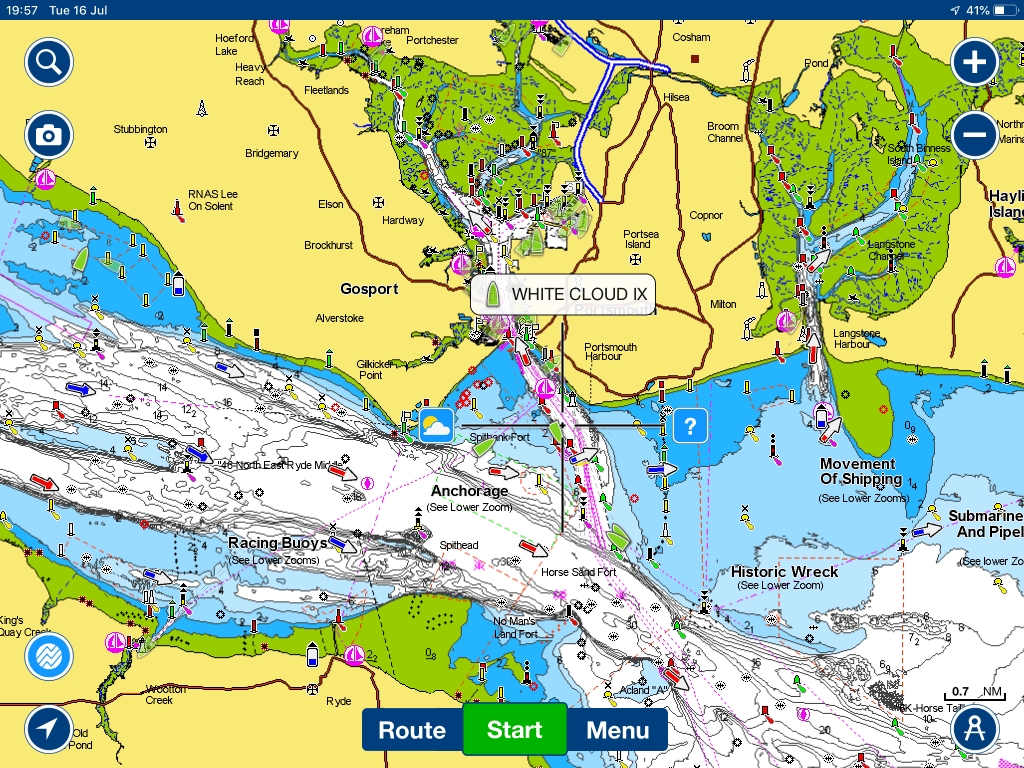
Click on Menu then on Connected Devices. You will see that Navionics will automatically be connected to one of our products. If it does not connect automatically, then you will need to manually set up the connexion as explained below.

If the automatic connexion does not work, then you have to manually set up the NMEA connexion. Click on the ‘+’ next to Devices. Then, at the bottom click on ‘Add Device’. You will need to enter the following details depending on the protocole mode you’ve chosen for the WLN10/WLN30/NavLink2:
If UDP:
If TCP:
After having entered the details, click Save.

After having set up the NMEA connexion, you must go to the ‘Map Options’ menu.

Click on ‘AIS Settings’

In that menu, you can now activate to display AIS targets but also to set up CPA and TCPA alarms. Depending on the values you set for CPA and TCPA alarms, your tablet or smartphone can also trigger an audible alarm.

Now, the AIS targets will be overlaid on your map. Touch a target to get its name and click ‘?’ to get more information about the AIS target.

iAIS is a free and simple iPhone/iPad app to display AIS targets. It was the first app in the world to display in real time AIS targets.
In order to receive AIS targets in real time, you will need an AIS receiver/transponder with built-in Wi-Fi or simply connect a NMEA-WiFi server to your AIS receiver or transponder.
This post explains how to set up an NMEA connection and to receive NMEA and AIS data in the app and also explains how to configure AIS parameters and to upload Navionics charts.
After having closed all your apps, make sure you are connected to the WiFI and open the iAIS app.
At the bottom of the app, click on Instruments.
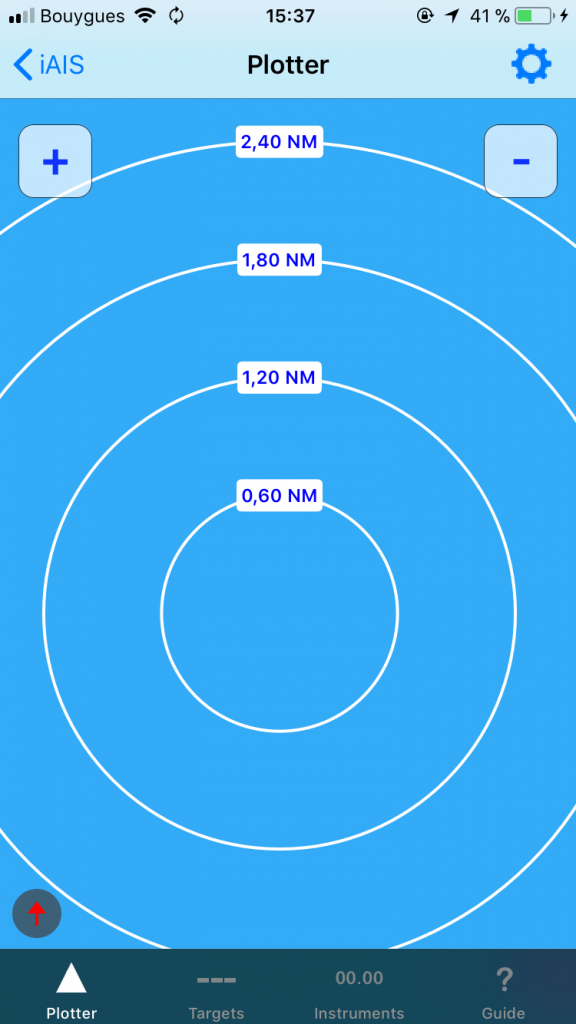
Then on the blue gear at the top right as shown in the picture below.
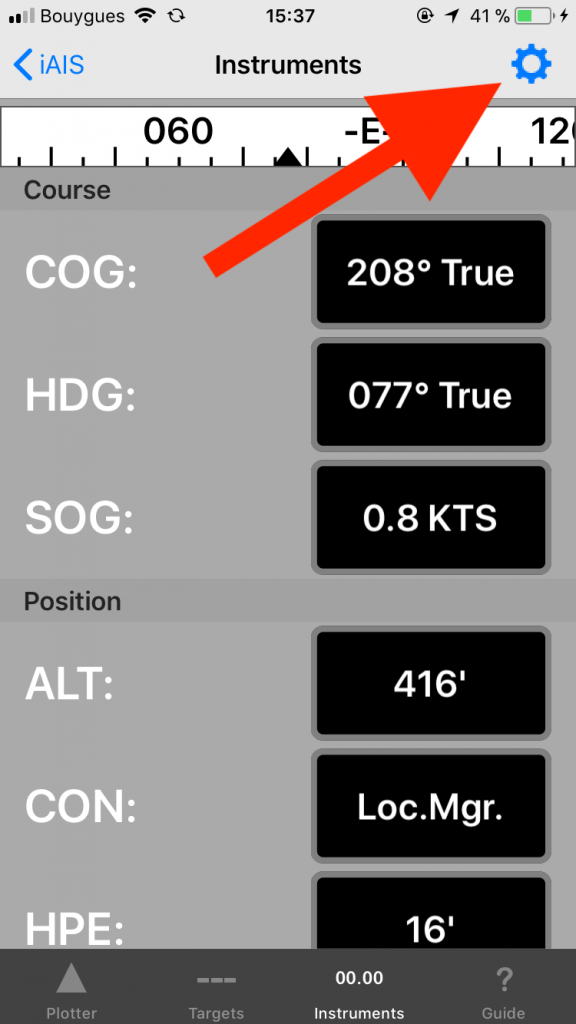
Then click on TCP/IP.
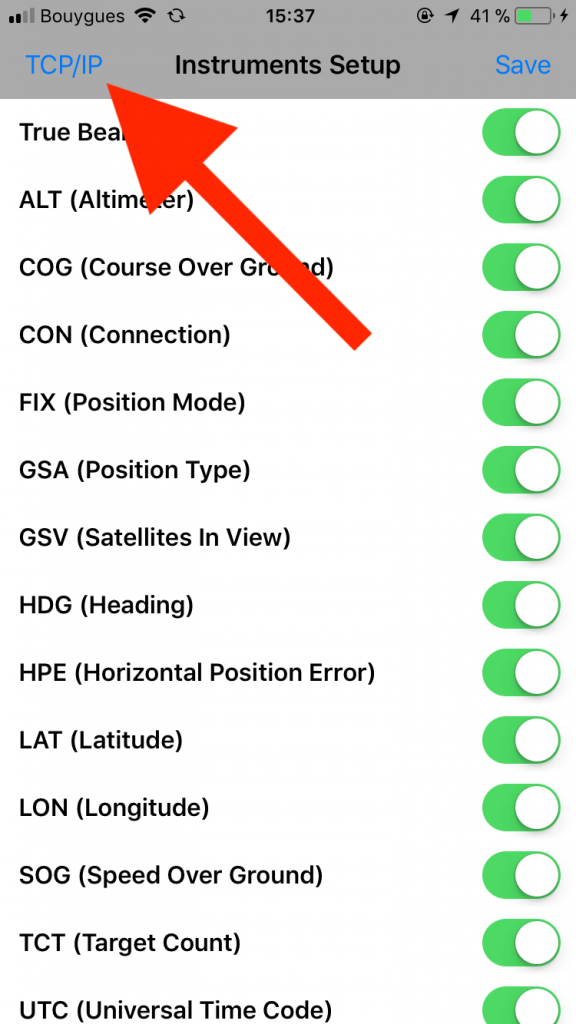
As shown in the screenshot below, you need to fill in the following parameters:
In this page you can also enter your MMSI number (then click on the button next to Tx) so that the iAIS application will transmit your position to AIS sites like Marine Traffic, BoatWatch, etc. You can also use your iPhone/iPad’s internal GPS instead of the GPS data transmitted through the Wi-Fi of your AIS transponder or NMEA-WiFi server.
Then, please toggle button next to Link.
If you receive data, then NMEA data will start streaming in the black box at the bottom of the application.

Afterwards, please click twice on Save and click on the Plotter tab. The AIS targets will now be displayed.
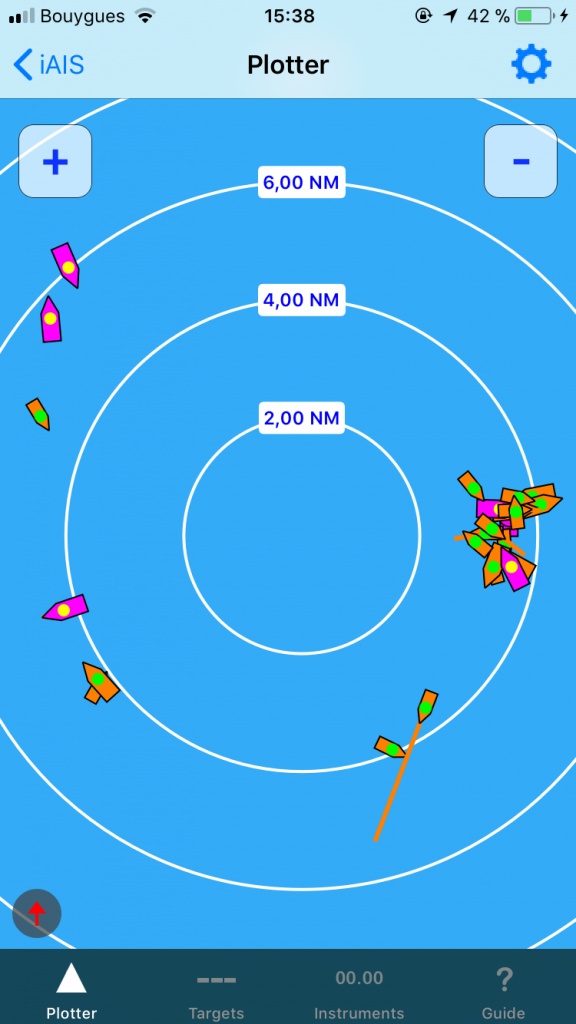
Since the last update of the iAIS application, you can overlay Navionics charts. There is no need to re-purchase Navionics charts if you have already purchased them in your Navionics app.
If you have a Navionics account and you want to use them to receive AIS targets, then please click on the Plotter tab and then click on the gear in the top right corner. At the bottom of the page you will see ‘Buy Navionics Charts Add-on’. After purchasing this feature, please click on the Login button and enter your email address and password used by Navionics. After the application has found the status of your Navionics Charts subscriptions, please click on Done and then toggle the button next to Navionics Charts as shown below. Afterwards, click Save and the Navionics Charts will appear on your application.
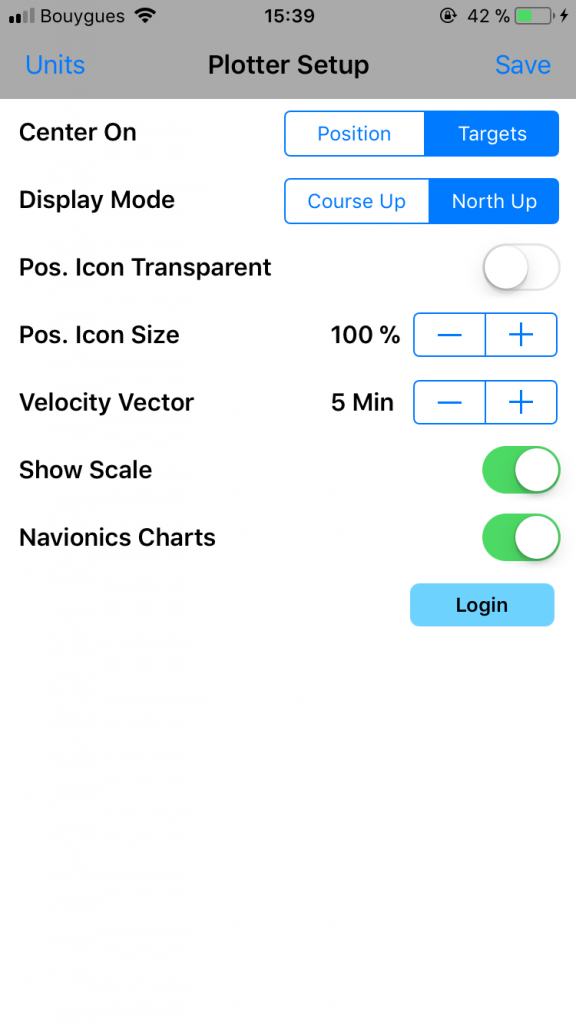
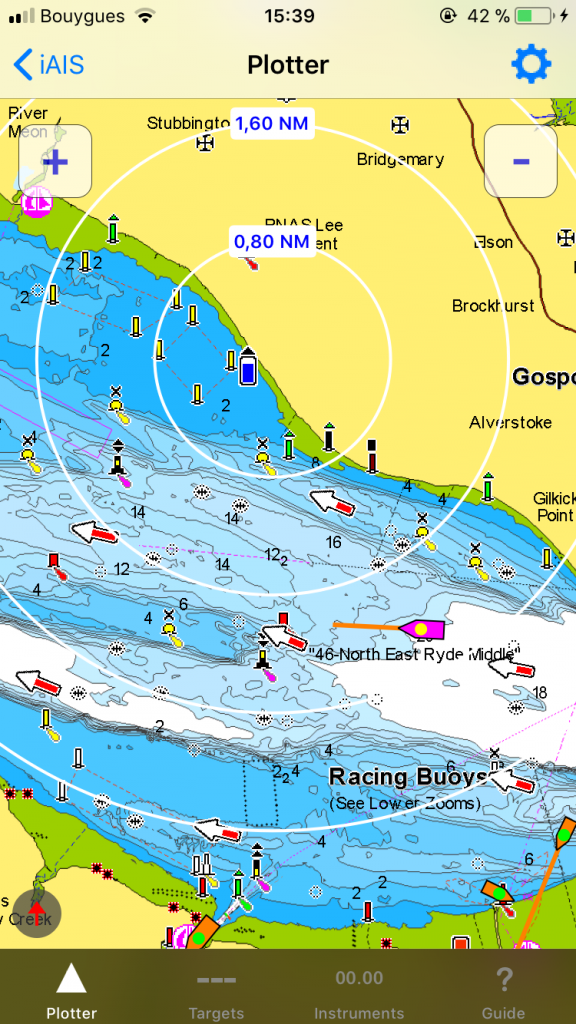
Once you have AIS targets on the Plotter tab, you can touch a target and the boat information will be displayed as shown in the picture below.
If the target has a yellow dot on it then it means that static data has not yet been received (boat name, dimensions, boat type, etc.). This data is transmitted less frequently than the position data and MMSI number. The static data is updated every 3-6 minutes.
Targets in Pink are Class B vessels (pleasure craft, etc.). Vessels equipped with class B transponders transmit static data (name, MMSI) and also dynamic data (COG, SOG, latitude, longitude, etc.).
Targets in Orange are Class A vessels (commercial, ship, passenger transport, etc.). Vessels equipped with class A transponder transmit more data such as destination, length, draught, etc.

If you have instruments connected to your NMEA-WiFi server or AIS transponder/receiver with built-in Wi-Fi, then the iAIS application can display data from these instruments. To view the data from these instruments, simply click on the Instruments tab.
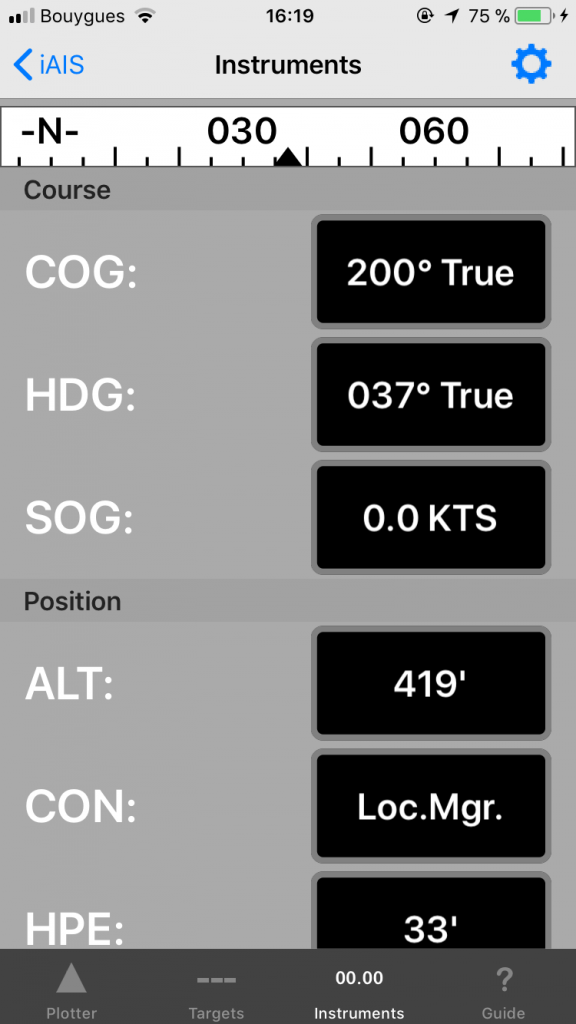
In the settings app, connect your iPad or iPhone Wi-fi to the Digital Yacht Wi-fi from an NMEA to WiFI server or from an AIS transponder with WiFi.
Tap the Instruments item in the toolbar at the bottom of the iNavX.
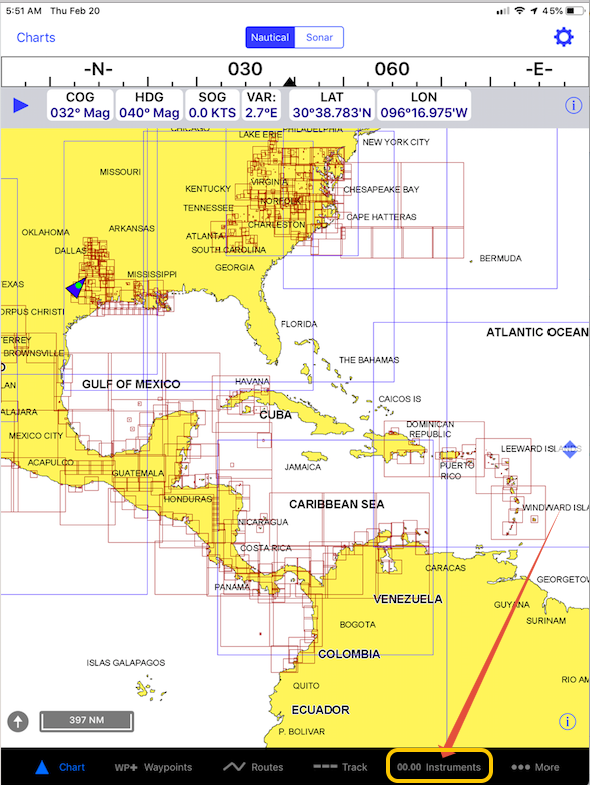
Tap TCP/IP in the upper left corner of the Instruments.
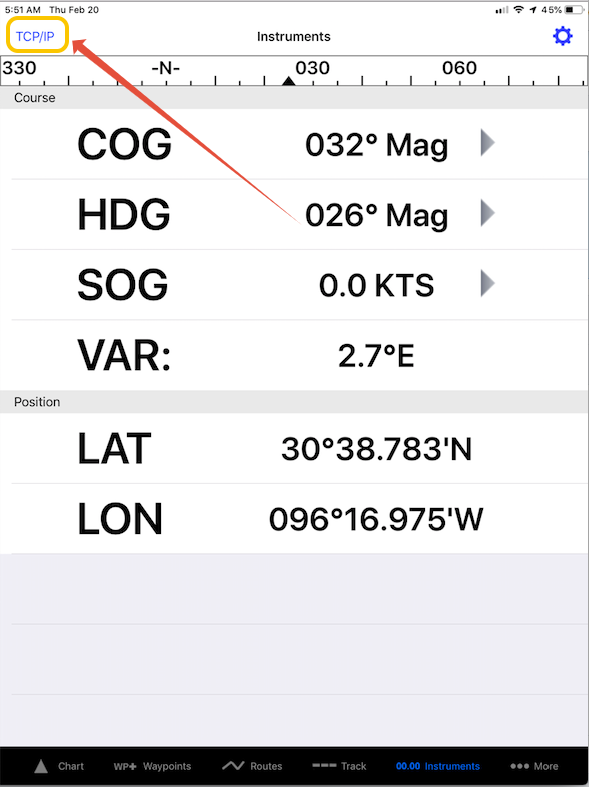
In this section, you can set up the NMEA connection with the following settings:
Below is also to set up the different NMEA functionalities such as sending data to an autopilot. Once all configured, toggle the link switch to the On.
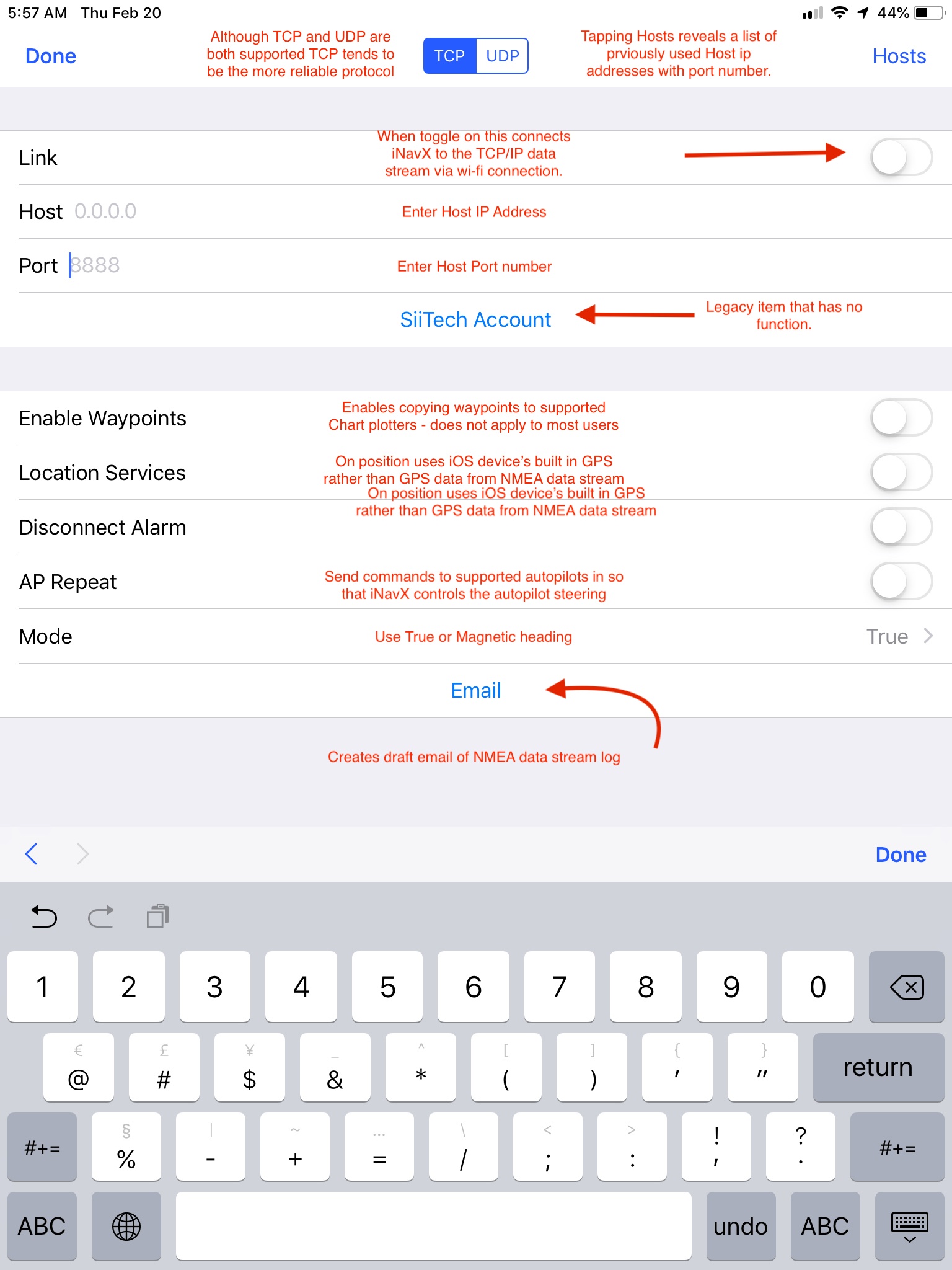
Once toggled on there should be NMEA data sentences streaming in the console indicating that iNavX is receiving NMEA data.

There are settings that can toggle how any AIS targets are displayed on the charts in iNavX on the Chart Settings page. You can access the chart settings page by tapping More in the iNavX toolbar, then Settings in the upper right corner, then Chart on the Settings page. Scroll down to show the 3 different settings for how AIS targets are viewed.

AIS targets appear when viewing a chart. The obvious limitation is the range capability of the AIS device in the onboard network. Also AIS Targets can be viewed as a list on the Targets page by tapping the TCT instrument in the instrument banner. This list can be sorted by Range, CPA and Alpha by tapping the sorting icon in the upper right corner. MMSI numbers will resolve to vessel names after appropriate refresh of data from the station broadcasting the data.
Tapping individual targets by either tapping the icon on a chart or by tapping it in the list will open an information window about the specific target. Tapping the magnifying glass icon will highlight the target so that it can be more easily followed when in chart view.
You can also configure AIS alarm. The setting is on the More page found by tapping the More item in the iNavX toolbar.

To receive NMEA data in iRegatta, the app has the settings in the iOS settings app.
Go in your iPhone/iPad settings menu and scroll down to the iRegatta app. Then, you need to scroll down to the “WIFI NMEA” section.
Turn on “WiFi instrument data”, and fill in the IP address: 192.168.1.1, port: 2000 and choose UDP for TCP/UDP.
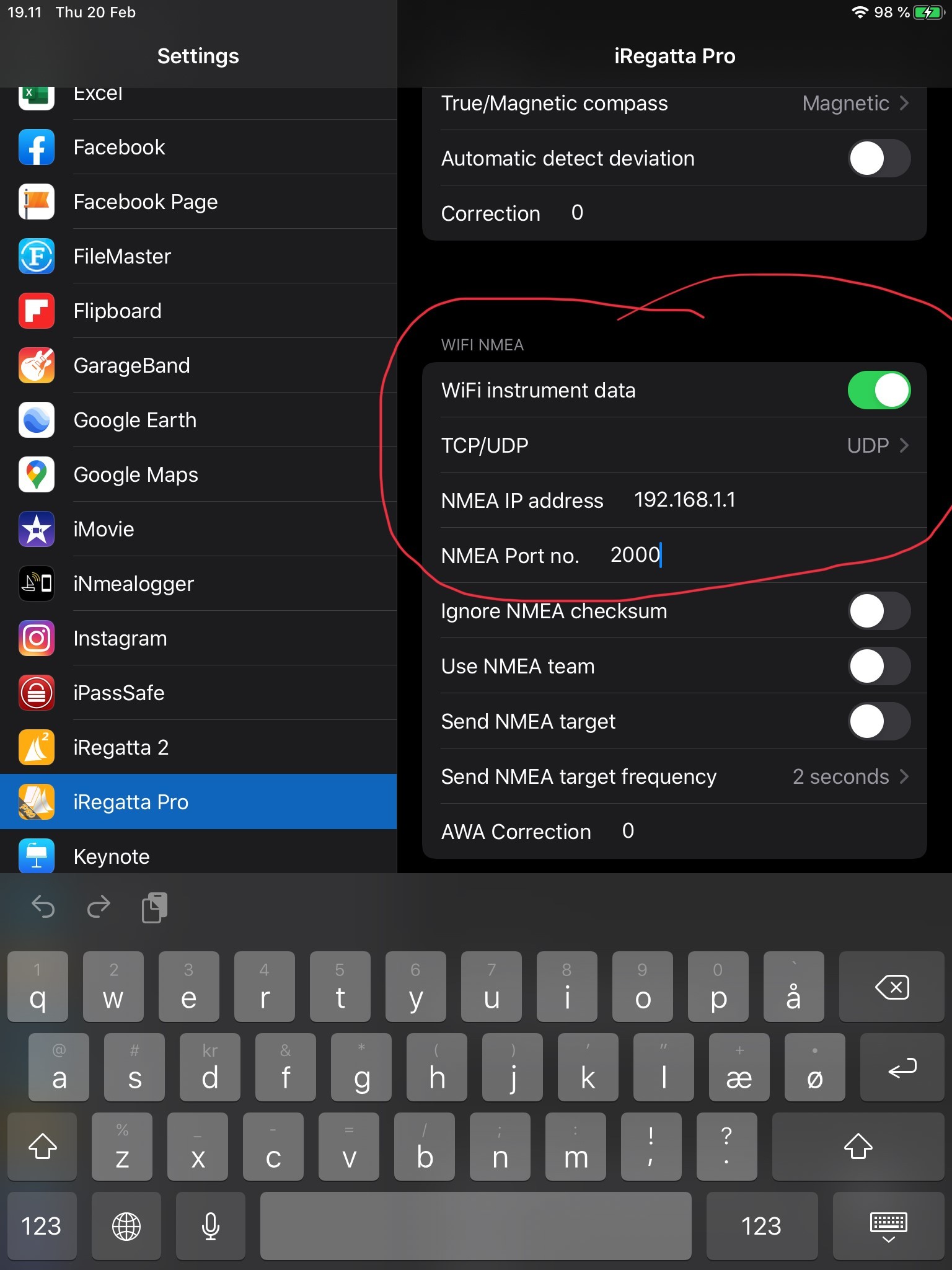
Showing AIS in iRegatta require an in-app-purchase. AIS will be shown as a radar view.

To receive NMEA data in iRegatta 2, the settings are inside the app.
Tap the menu button in the upper left corner.
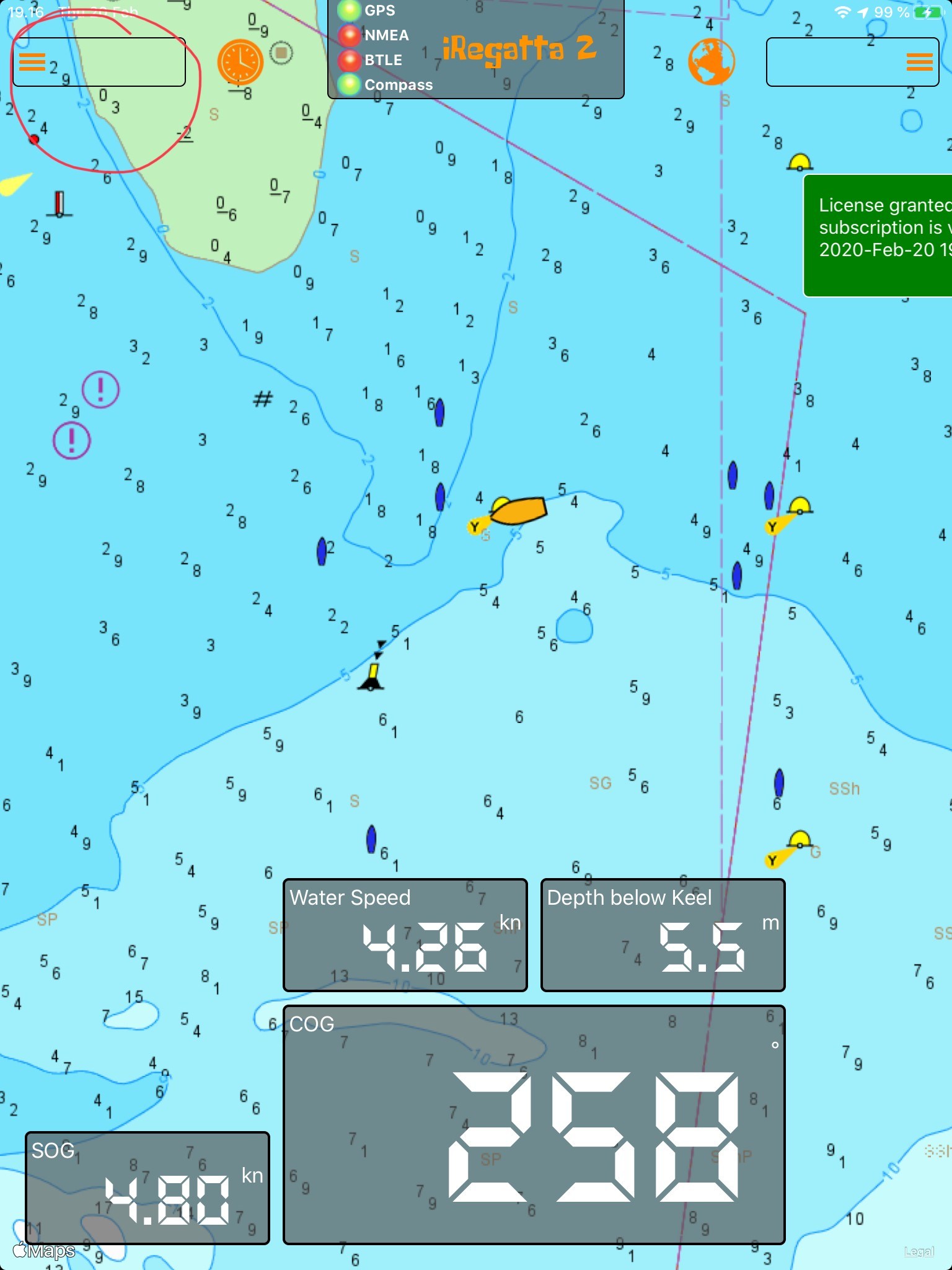
Then, you need to select “Settings” in the menu.

Then, scroll down and Enable the button next to WiFi Instrument data and enter the following:
NMEA IP address: 192.168.1.1
NMEA Port no.: 2000
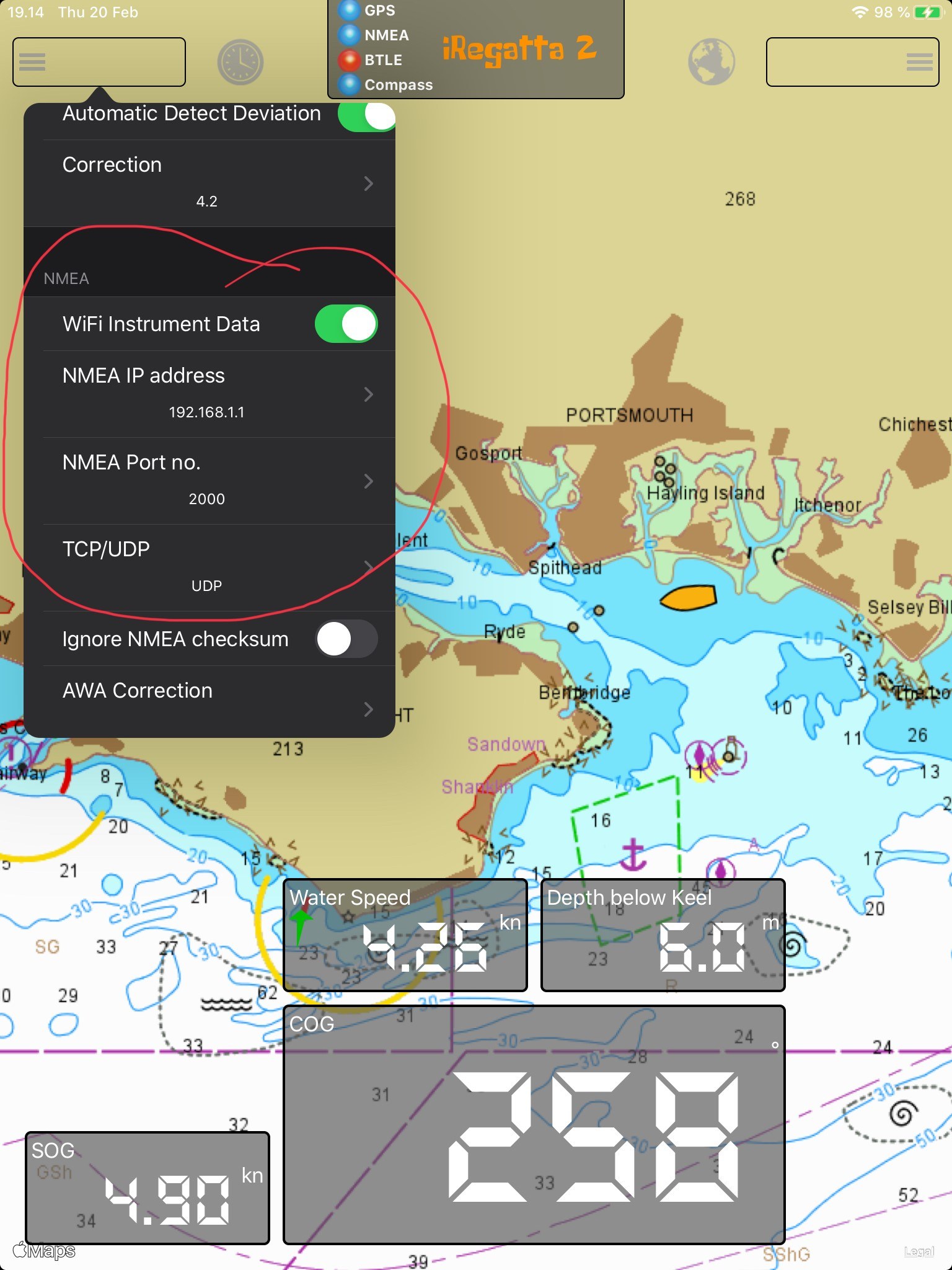
If you have an AIS receiver/transponder with built-in WiFi or an NMEA to WiFi server connected to an AIS, you can overlay AIS targets on the iRegatta app.
You need to open the right menu.


Then turn on AIS.

Here is the instruction, how to connect the external Wi-Fi AIS or NMEA to WiFi servers to the iSailor app:
Run the iSailor app and tap on the “Settings” tab. The Settings menu is needed to adjust user settings, purchase, restore charts and for other functions.
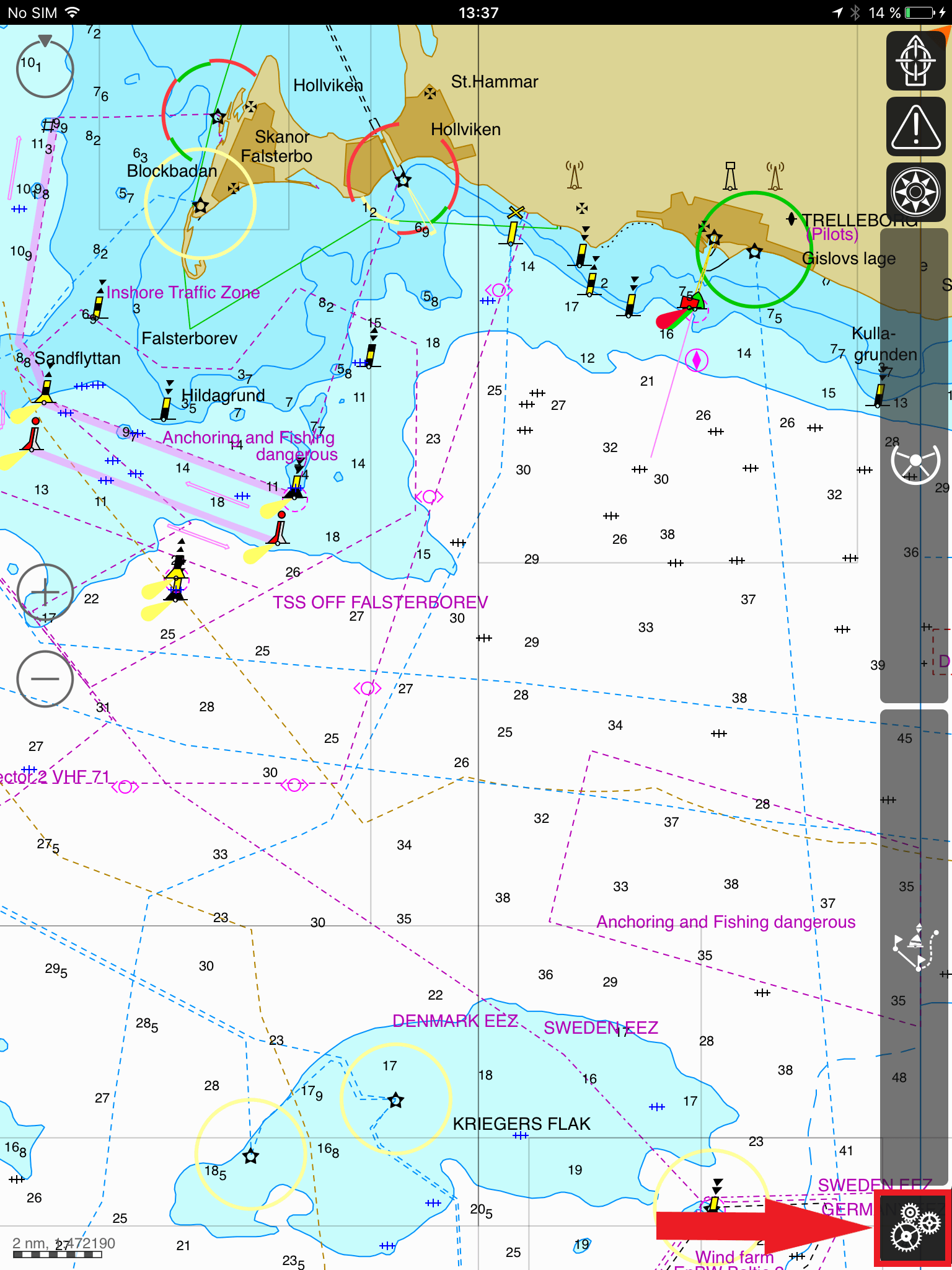
Tap the “Sensors” menu item

In that menu, there are some in-app purchases. The NMEA section is needed for filtering purposes of the incoming NMEA data. The AIS section is needed for operation with AIS targets. Tap on the section you require and choose the options you need if you have not already purchased those options. If you have already purchased those options then go to the next section:
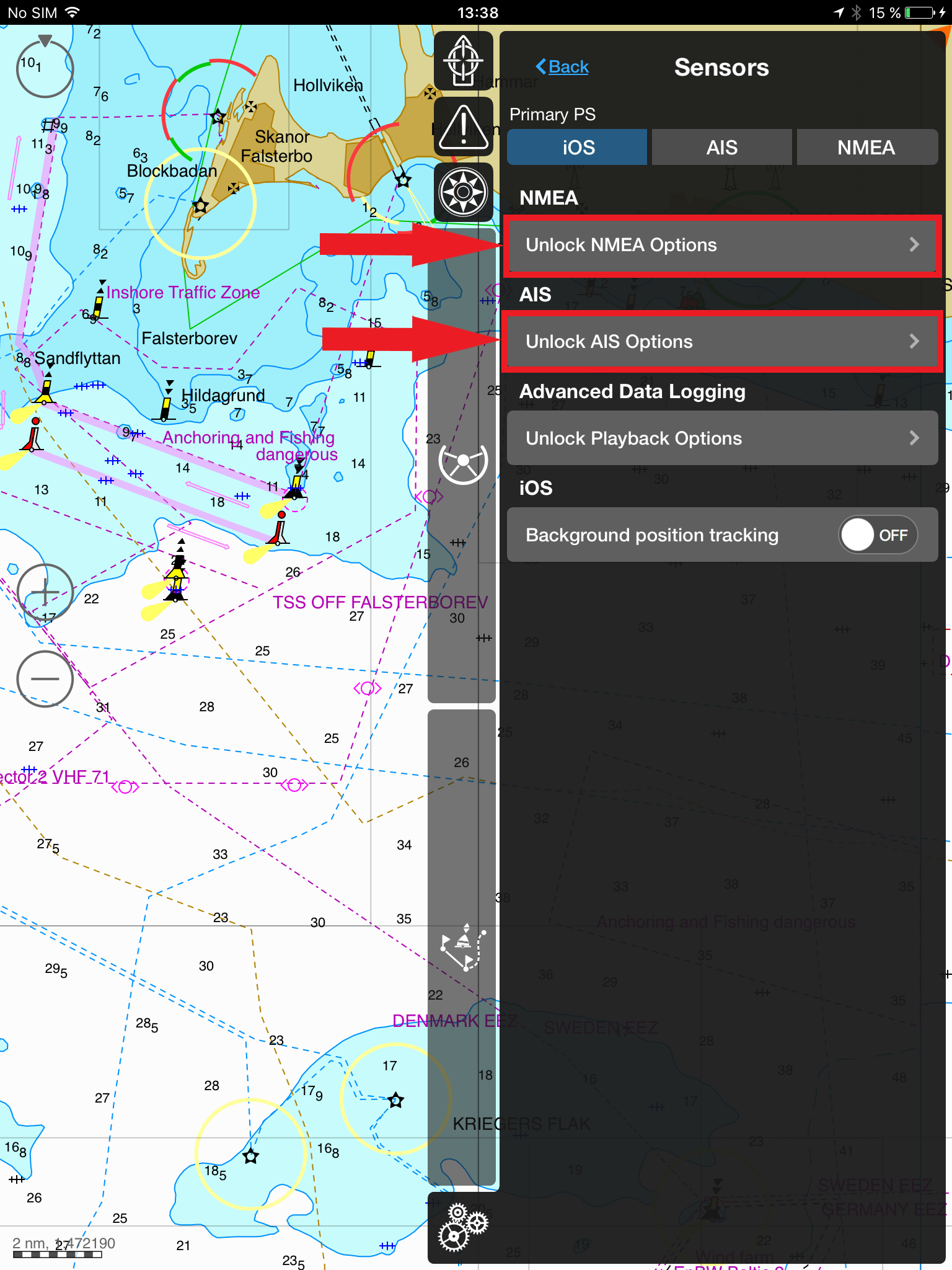
Once you have purchased the right options, go back to the “Sensors” tab -> you will see the advanced settings appears (according to the purchased options).
Tap on the “Connection Settings” on the “AIS & NMEA Connections” section.
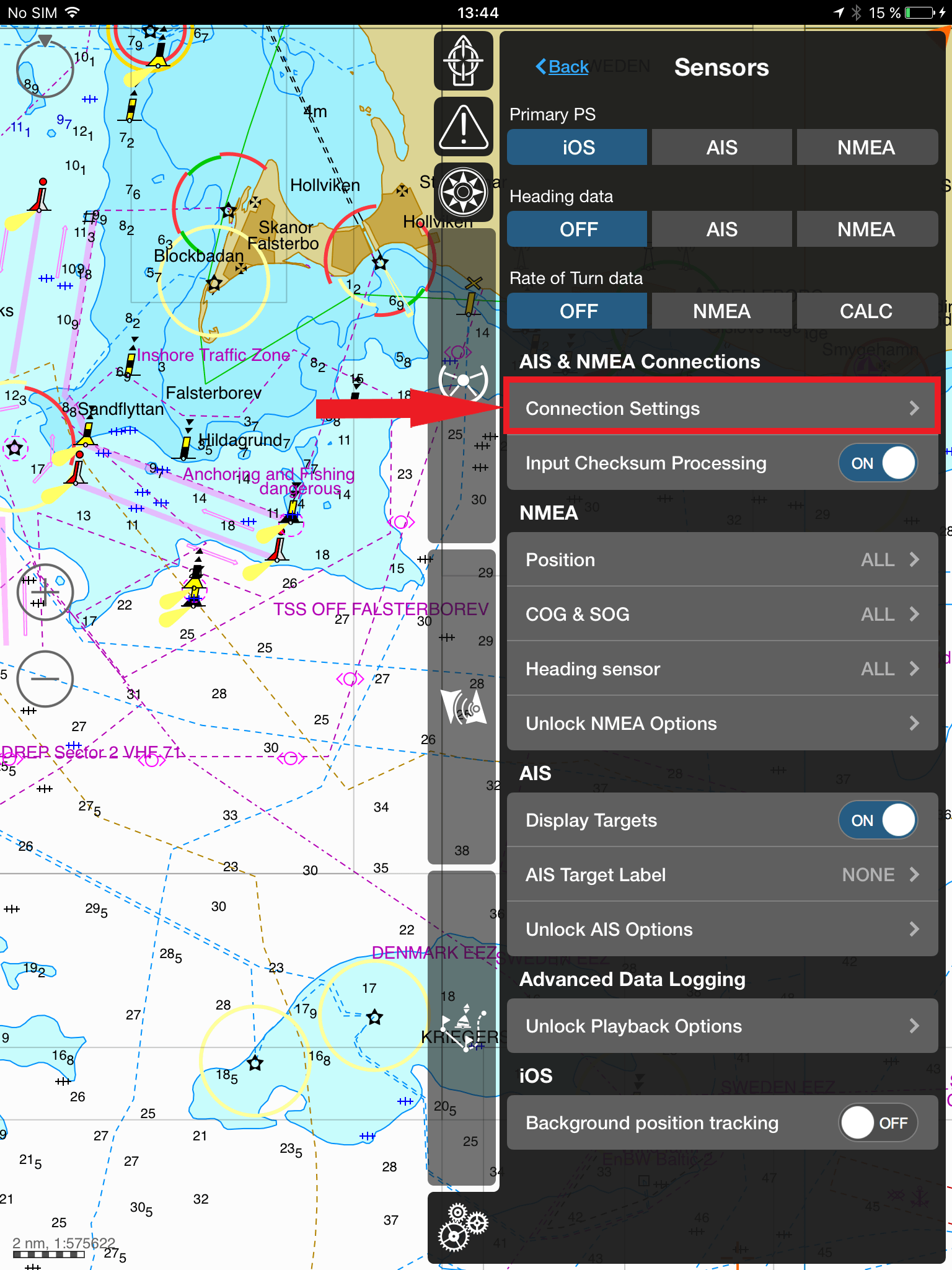
Click on Add Connection.
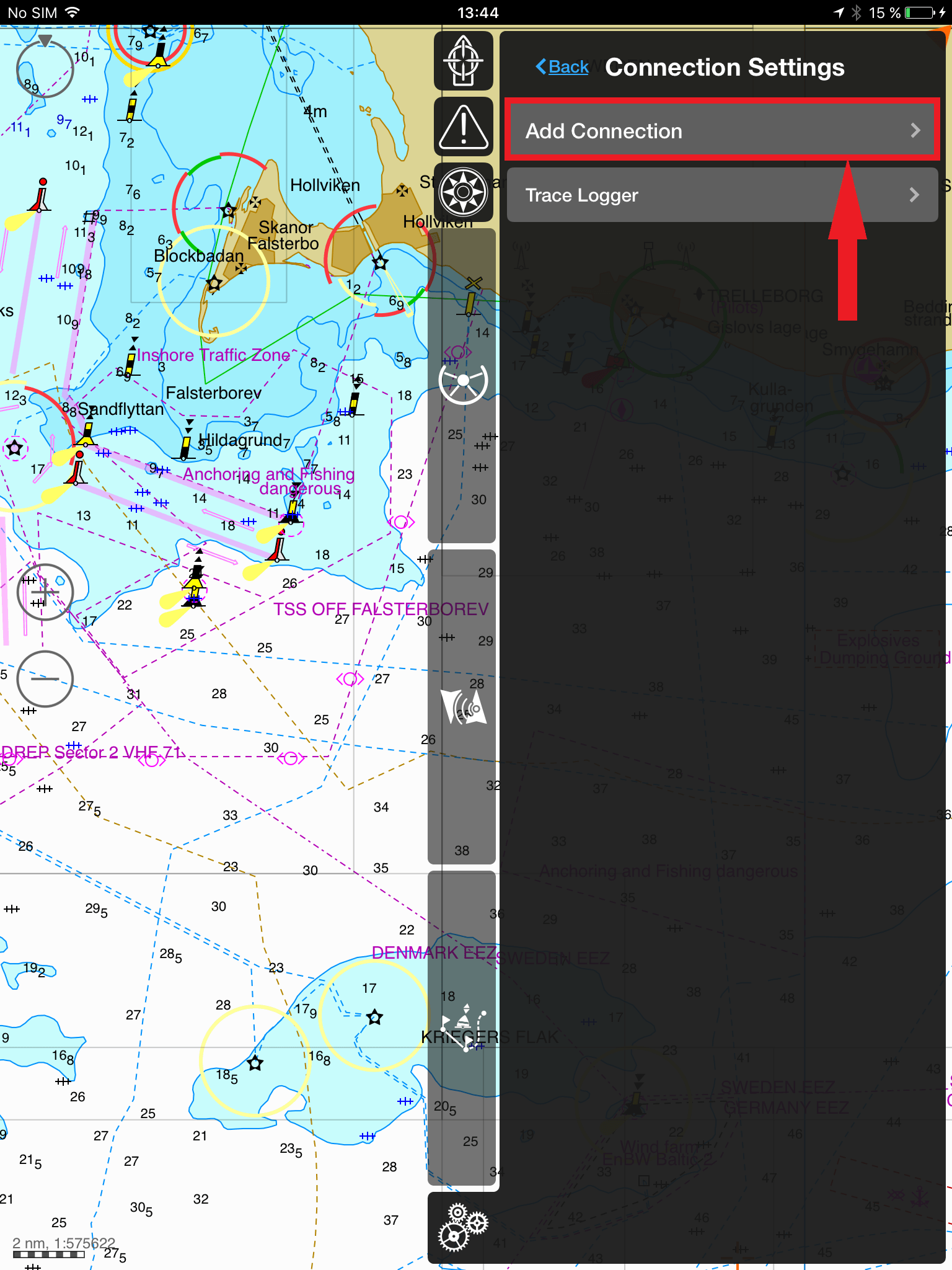
Fill in the Connection table:
– input the connection Name. For instance, Digital Yacht AIT3000 or Smart WLN10, etc.
– Choose the protocol type (we always recommend using the UDP protocol).
– set the Address “192.168.1.1”.
– set the Port “2000”.
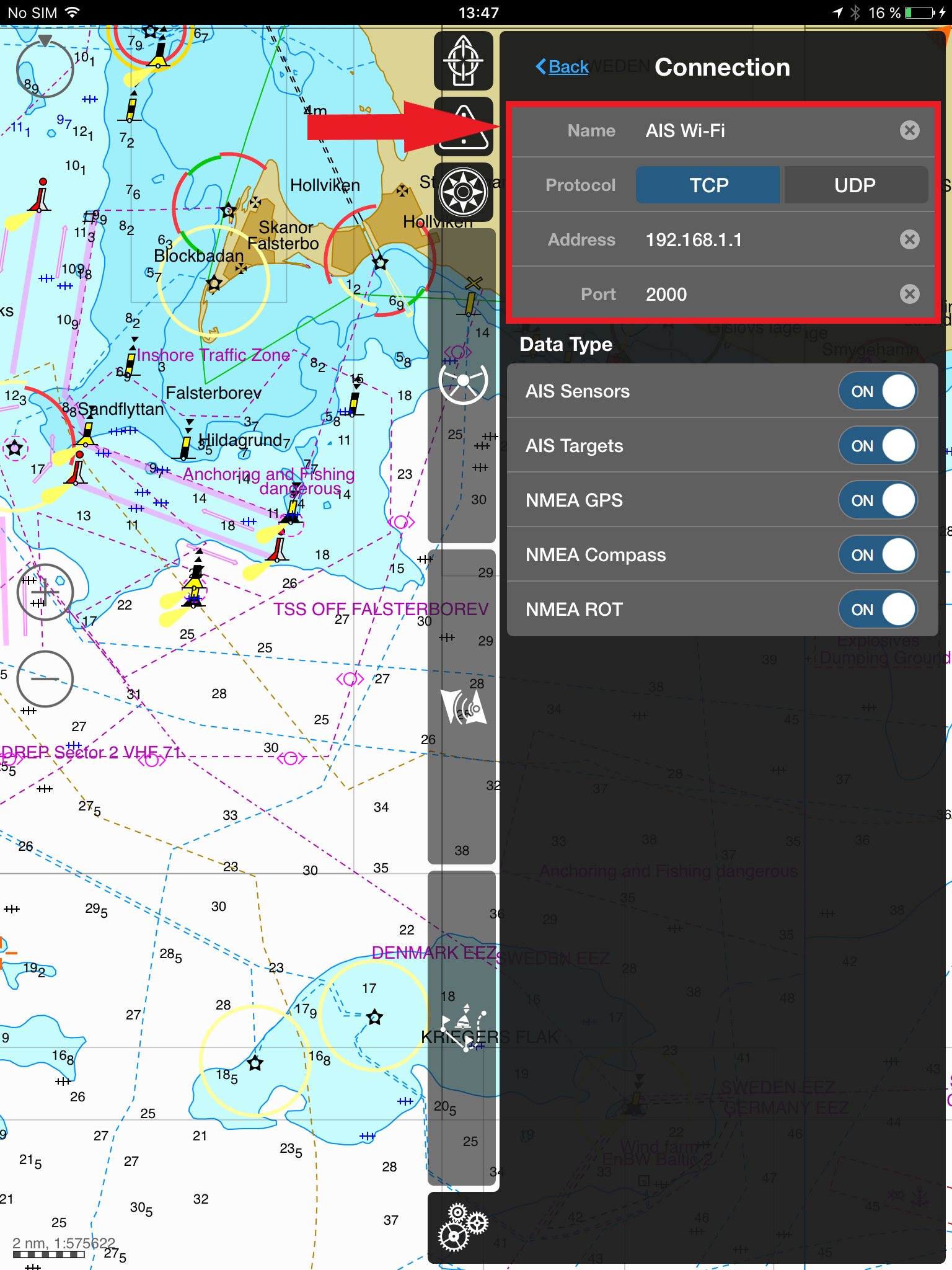
Go back to the “Connection Settings” -> if the connection was established, there will be a check mark on the tab.
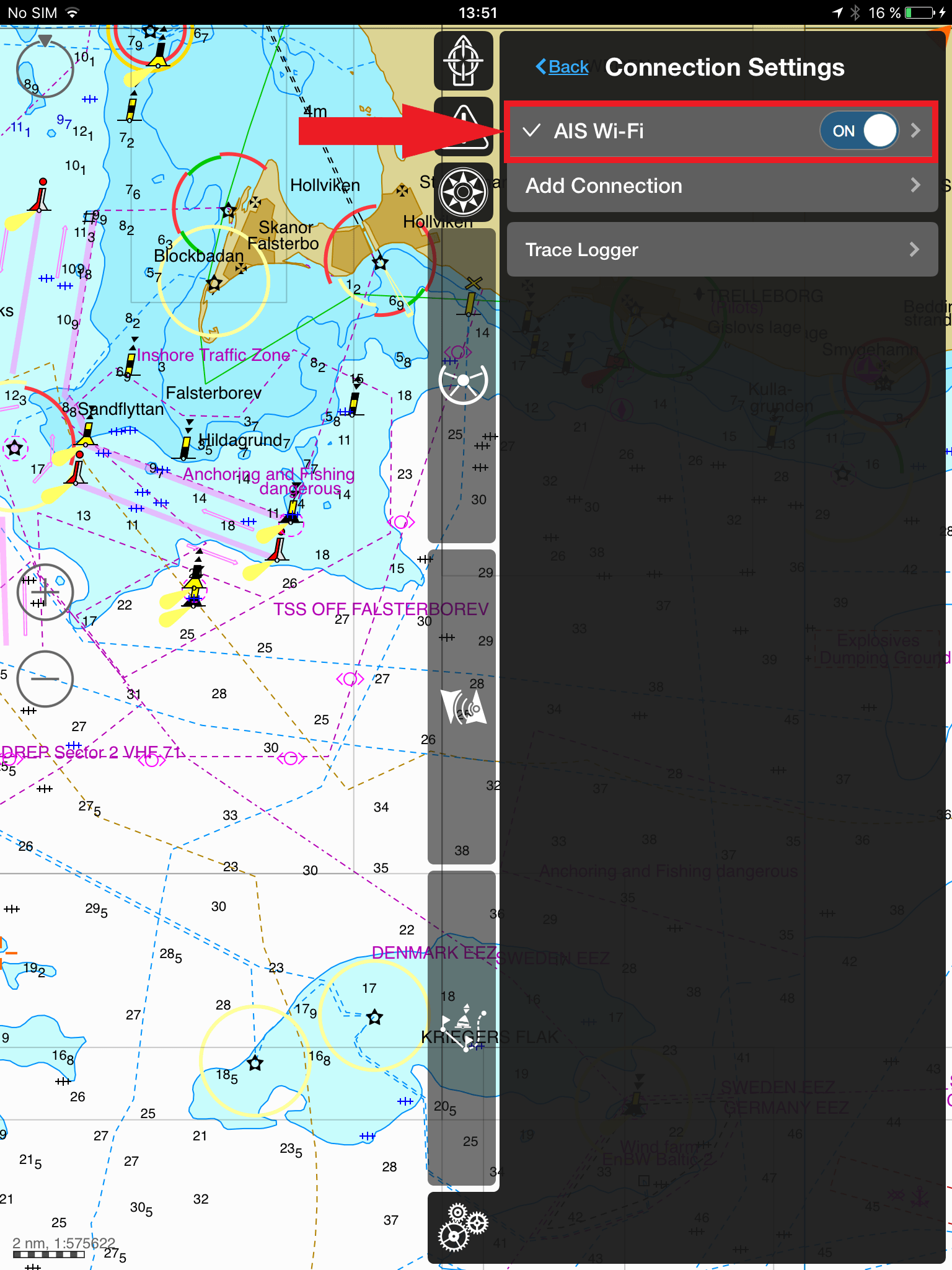
Go to the “Sensors” tab and set the appropriate settings (Primary PS – AIS/NMEA, Heading data – AIS/NMEA, etc.)
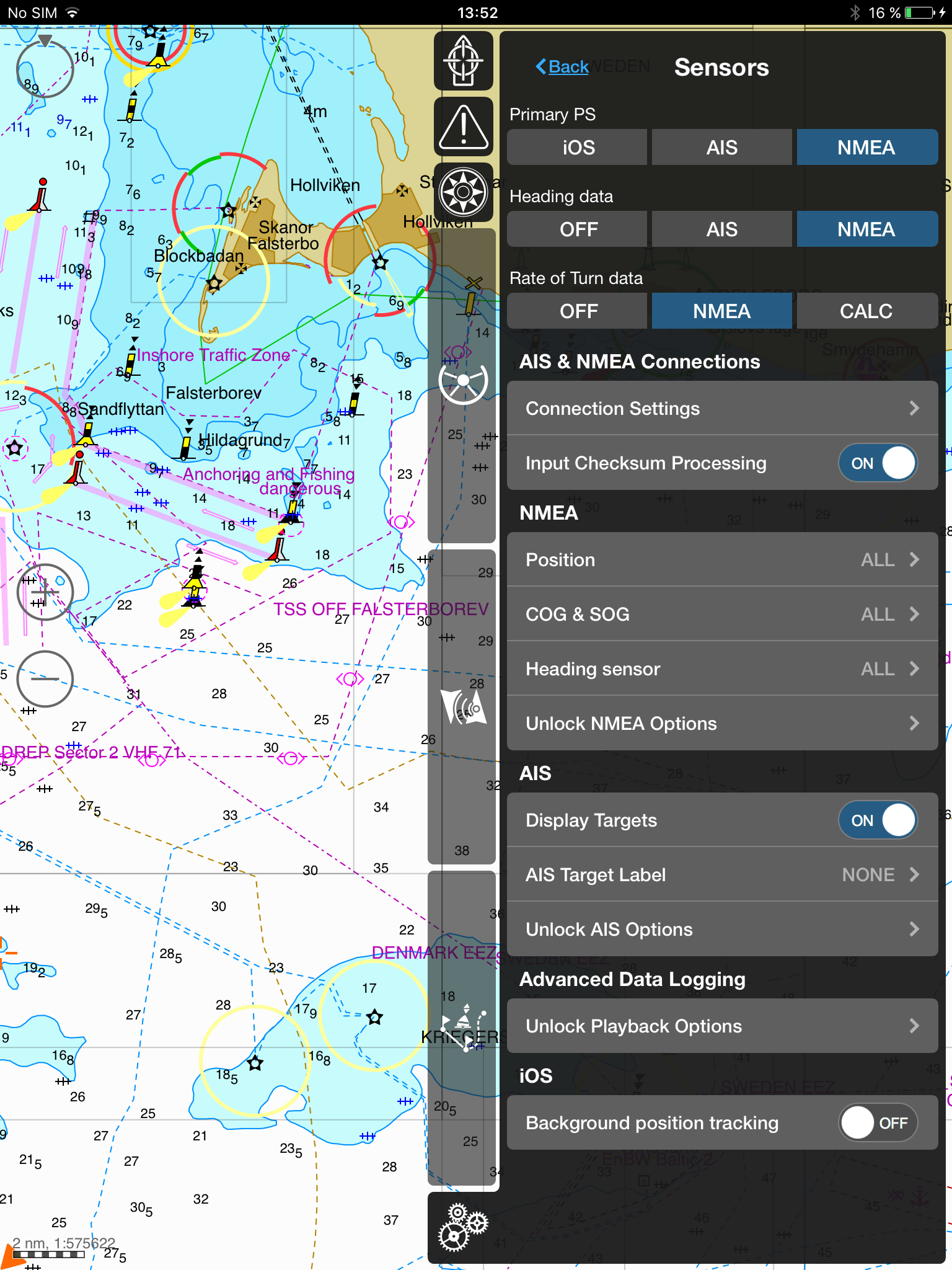
On the “Monitoring page” you can check the following data: position, sensor, route and schedule, track recording.

NavLink is a low cost app designed for use with an iPhone or iPad. It transforms your iPad into a full function chart plotter with detailed electronic charts and an overlay of your boat’s position, track and heading.
This post explains how to receive NMEA data and to display real time AIS targets on Navlink.
In the settings app, connect your iPad or iPhone Wi-fi to the Digital Yacht Wi-fi from an NMEA to WiFI server or from an AIS transponder with WiFi.
Go to the Navlink’s settings menu.

Go to the ‘AIS, GPS & NMEA Link’ menu

Whether you are using an iPad or iPhone, you need to enter the following parameters:
If the NMEA connection is valid and complete, you should start seeing NMEA data sentences streaming in the console indicating that NavLink is receiving NMEA data.

After having configured your NMEA connection, you must activate AIS targets.
Go back to the main menu and go to Manage Chart Layers.

Then, toggle the button next to ‘AIS Ship Layer’

Go back to the main menu and go to ‘My Boat Details’ menu to set up your preferences for CPA and TCPA alarms.

Go back to the map, AIS targets will now be overlaid on your charts. Touch a target and touch the ‘i’ to get more information.

After having touched the ‘i’, you will obtain more information about the target including the CPA and TCPA alarms.

Your iPad/iPhone can trigger an audible alarm for the CPA and TCPA alarms that you’ve set before.

Besides editing charts, NV Charts have also developed an Android/iOS/Windows/Mac app.
After having connected your tablet, PC or smartphone to the WiFI of our AIS transponder or NMEA to WiFi server, open the NV Charts app on your device.
Reach the settings menu by pressing the setting button and click on GPS AIS.
Here in this section, as shown in the image below, you can set up the external NMEA source, GPS position and all the AIS parameters.
You can choose to receive the position from the internal GPS sensor or from NMEA. You can receive the GPS data from NMEA if you have a GPS antenna connected to the NMEA to WiFI server.
Here you can toggle buttons to show Class B and Class A AIS targets.
In this section, scroll down to NMEA and enter the following settings:
Once you have entered the data above, tap the ‘Connect’ button at the bottom.
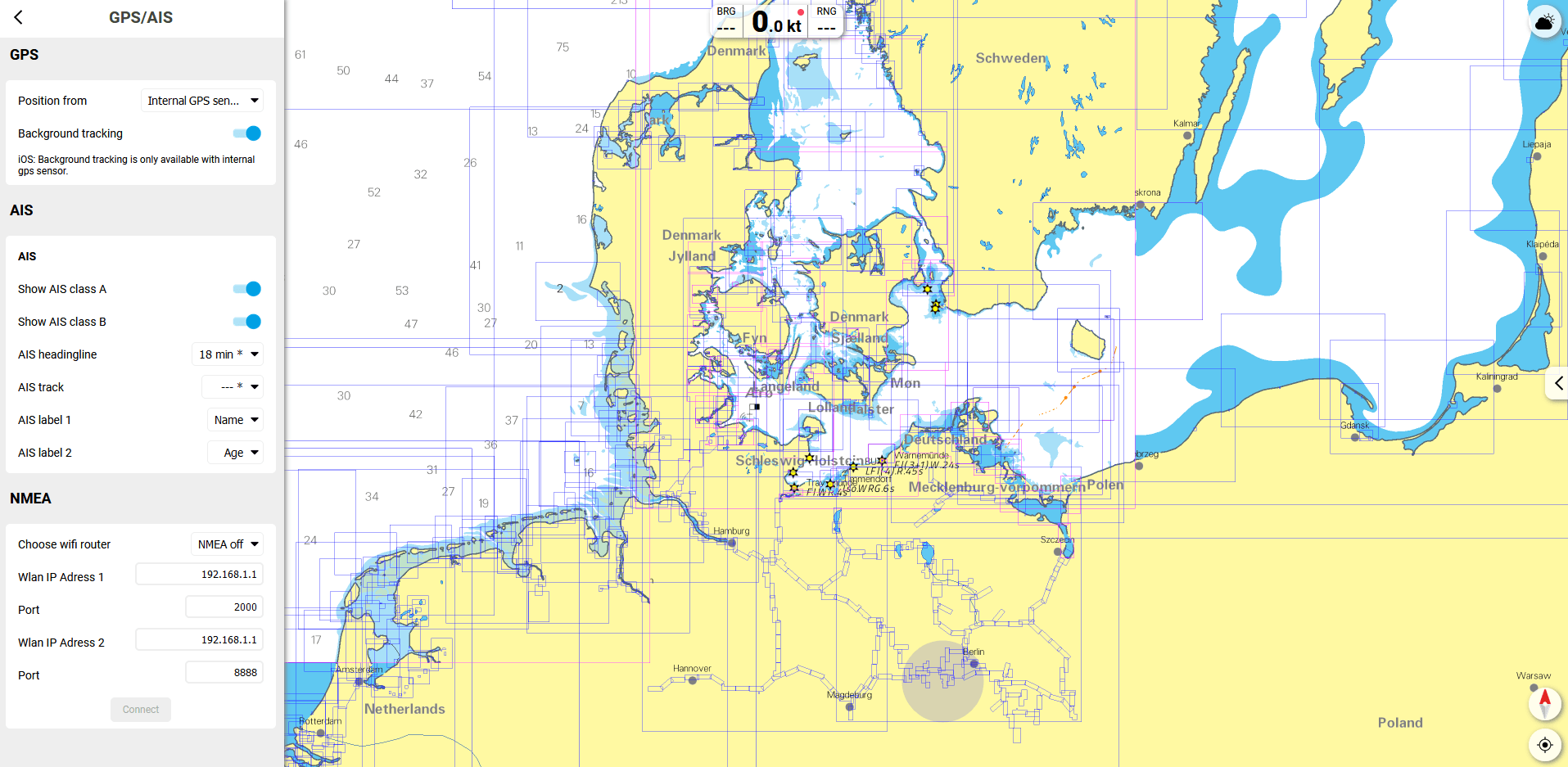
OpenCPN is one of the most popular marine navigation software packages and is completely Open Source, meaning that Windows, Mac and LINUX users can install and use the software for free!
This section explains how to receive NMEA data in OpenCPN V3.2 or higher from an NMEA to USB adaptor or from a sensor with USB output like our GPS antenna.
First of all, make sure that the relevant USB driver for your Digital Yacht product, is installed on the computer.
During the “Discovery” process, the operating system will allocate a device name to the USB connection. On Windows PCs these are always “Virtual COM Ports” and will be numbered COM1 through to COM256, while on MACs and LINUX PCs these will be device names “tty.usb1”. Before you can setup OpenCPN, you need to know what device name has been allocated to your Digital Yacht Product and this varies between operating systems:
– For Windows PC, to find out what COM Port number has been allocated, you will need to run the “Device Manager”. The Digital Yacht unit will be displayed as “USB Serial Port (COMxx)” and it is the number (in this example 6) that we are interested in.
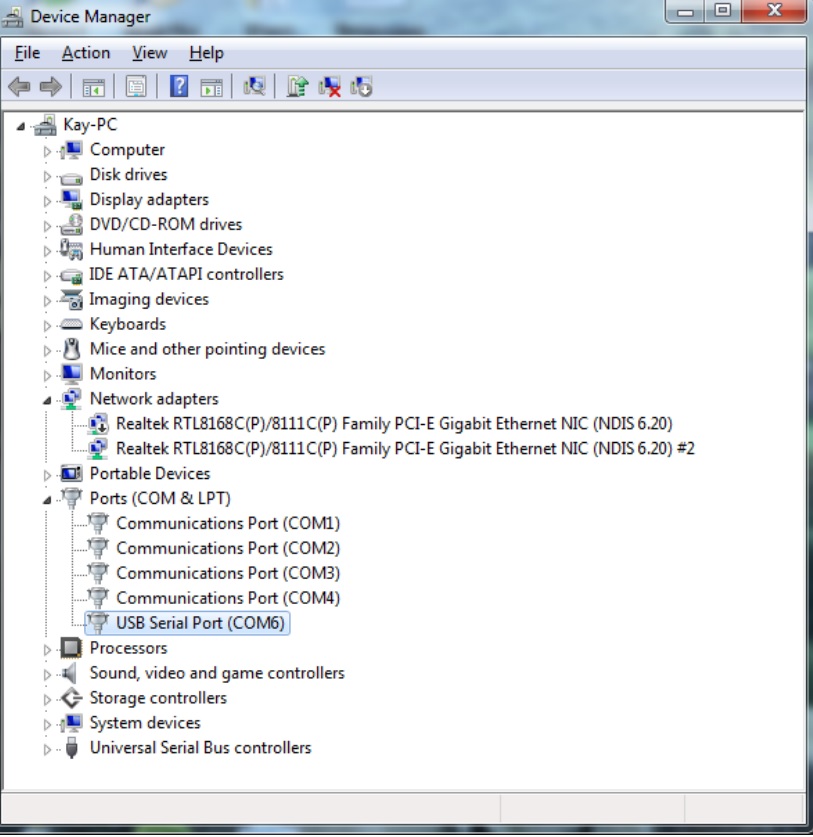
– For Macs, in Finder, click GO>Utilities and run the Terminal.app program. Then type “ls /dev/tty.usb*” which will then display the device name given to the Digital Yacht product, in this example “/dev/tty.usbmodem1d11” is our AIT2000 and “/dev/tty.usbserial-FTTQLRK4” is one of our NMEA to USB adaptor cables. Make a note of the device name(s) as we will need to enter this in OpenCPN.
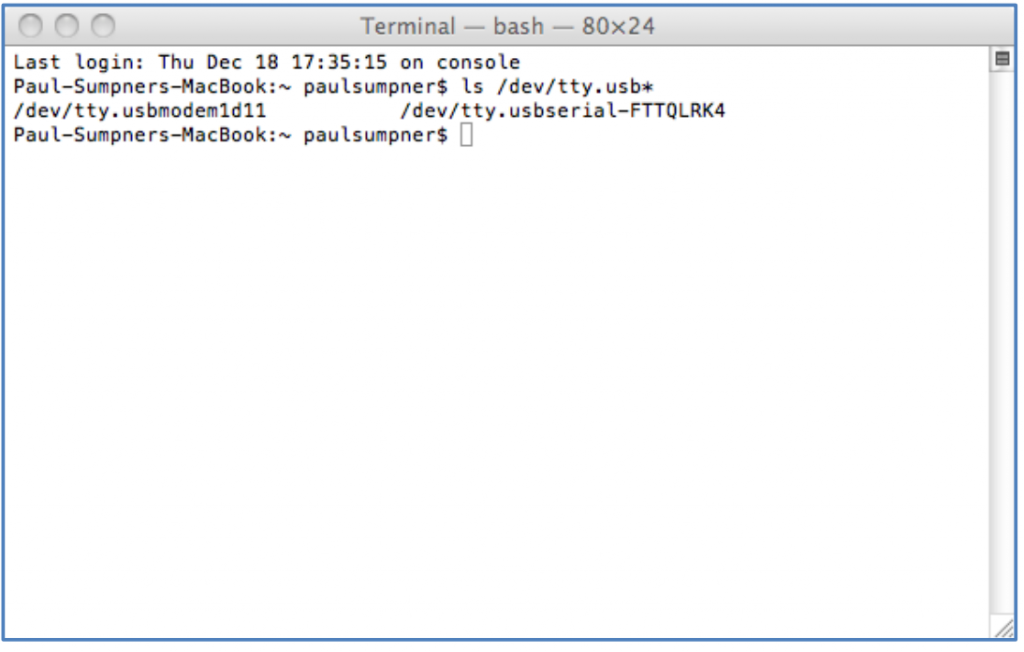
– For LINUX PCs, the exact command you use will depend upon which LINUX distribution you are using but for Ubuntu, click “Applications>Accessories>Terminal”. At the command prompt, enter the command;
ls /dev/ttyA* for AIT1500/AIT2000/AIT3000 and other AIS transponders products
ls /dev/ttyU* for all other products such as NMEA to USB adaptor, GPS with USB output, etc.
This will display the device name given to the Digital Yacht product. In this example below we have an AIT2000 connected that is given the device name “/dev/ttyACM0” and a GPS160USB that was given “dev/ttyUSB0”. Make a note of the device name(s) as we will need to enter this in OpenCPN
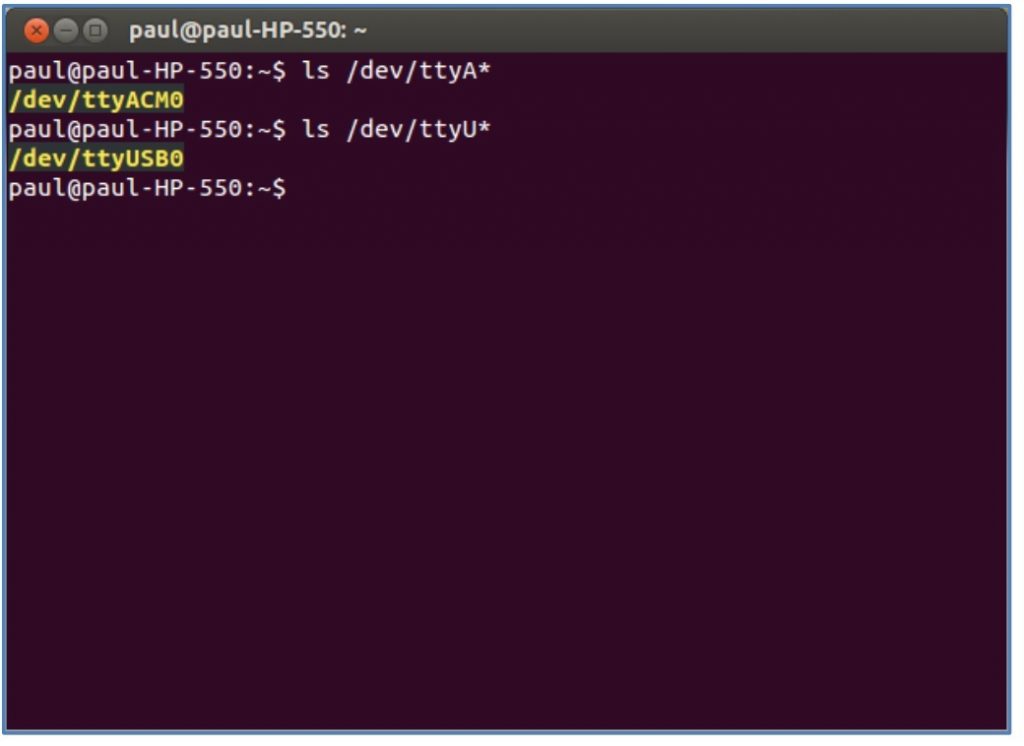
With the latest V3.2 and higher versions of OpenCPN you can have multiple data connections and to create a new connection you must click on the “Settings” icon (spanner) and then click on the “Connections” tab. As you can see, we currently have no Data Connections setup and so we click on the “Add Connection” button. Now we click on Serial then on the “DataPort“ drop down list and see what serial ports are available. Find the device name that matches the name noted earlier for your Digital Yacht product and select that device.

The default baud rate (data speed) is 4800baud which is the standard speed for most NMEA0183 devices, but if you are connecting one of our AIS products, you will need to change the Baudrate to 38400 baud.
None of the other settings usually need to be changed and once you are happy that everything is correct, click on the “Apply” button to save the settings and you will see the new connection now in the list. If you wish to test the connection, click on the “Show NMEA Debug Window” tick box and a new window will appear with the raw NMEA data scrolling down the page, showing the time it was received and the connection it came in on.
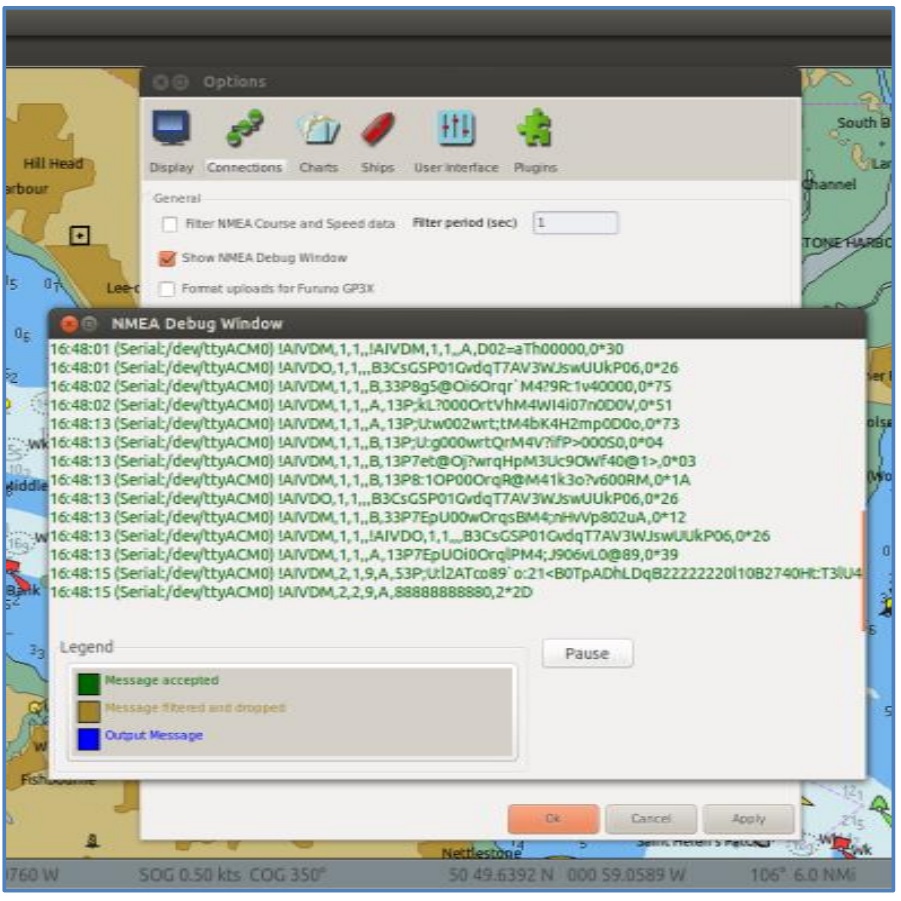
You can continue to add more data connections i.e. GPS, AIS, Instruments, etc. and once all connections are setup just click “OK” to exit and return to the Chart screen. Assuming that all of the connections are powered up and active, you should now see the Boat displayed accurately on the chart, if an AIS is connected then a series of AIS targets should be displayed on the chart and if you have the Dashboard Instrument Plugin installed, you should be able to display instrument data as well.
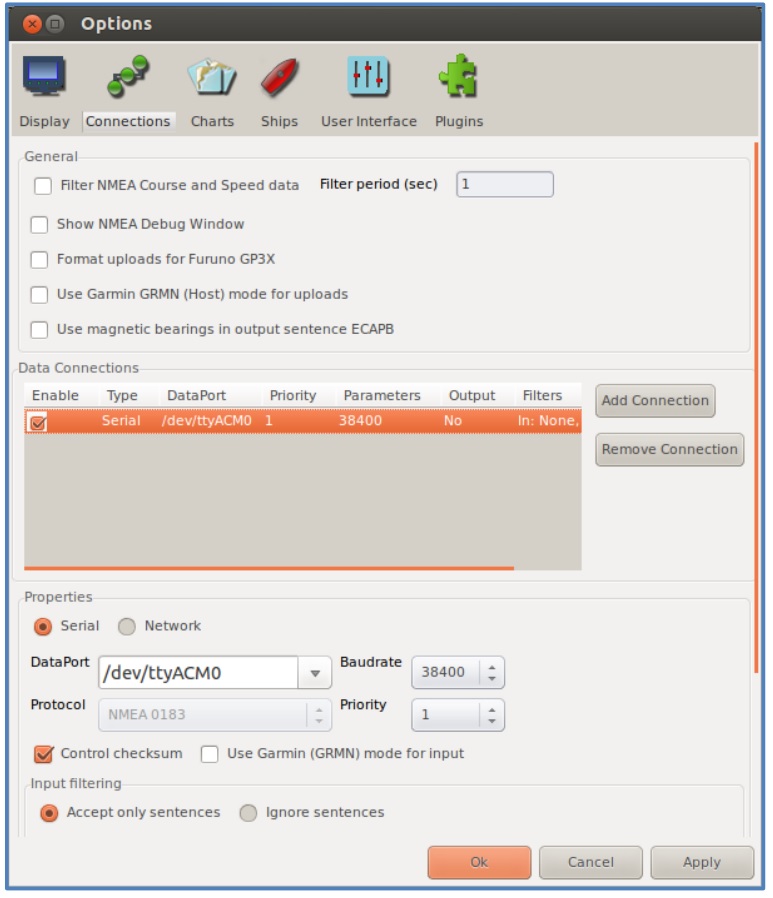
Important Notes
1) We have had some reports of customers having to go in to the Input Filtering “Accept Only” options and clicking the “Select All” Sentences button. There does not seem to be any rhyme or reason for this and we recommend only changing the Input Filtering if no data is being displayed and you are sure everything else is set and working correctly.
2) For Mac and LINUX users, if when you click on the drop down “DataPort” menu you do not see the device name that you had found previously in the Terminal program, you will need to manually type the name in to the box. We have seen this on some Macs and LINUX distributions with our AIT1500/AIT2000/AIT3000 products that appear as a USB Modem rather than a USB Serial Port. Make sure you include the full device name for example; /dev/tty.usbmodem1d11
If you have connected the USB output of an AIS transponder/Receiver or if your AIS is connected to an NMEA to USB adaptor, then you can overlay AIS targets in OpenCPN after having configured the USB connection.
You need to make sure that AIS targets are activated. Go to the top menu bar > AIS and tick the parameters you want.

You can also configure others AIS parameters such as CPA/TCPA alarms and the display of AIS targets in the OpenCPN menu. By configuring CPA/TCPA alarms, your PC can trigger an audible alarm.
If you want to configure those parameters, go to OpenCPN settings > Ships > ‘AIS Targets’ tab.

AIS targets will now be overlay in your charts.